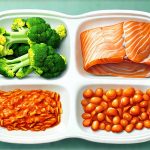Digestion, at its core, is an incredibly complex biochemical process – one that’s profoundly influenced by factors extending far beyond just what we eat. While dietary choices understandably take center stage in conversations about gut health and overall wellbeing, the environment surrounding digestion often receives less attention. Specifically, temperature plays a surprisingly significant role in how efficiently our bodies break down food, absorb nutrients, and even how comfortable we feel during and after meals. It’s not merely about avoiding extremes of hot or cold; the subtle interplay between ambient temperatures and digestive processes is fascinating, impacting everything from enzyme activity to gut motility. Understanding this connection can empower us to optimize our eating habits and create a more harmonious relationship with food.
The human body strives for internal homeostasis, maintaining a relatively stable core temperature despite fluctuations in external conditions. Digestion itself generates heat as metabolic reactions occur. Therefore, the surrounding environment impacts how much energy your body expends to maintain that core temperature while simultaneously processing food. Too cold an environment might divert blood flow away from the digestive system toward extremities, slowing things down. Conversely, excessive heat can lead to dehydration and potentially impair enzymatic functions. This isn’t about needing a perfectly climate-controlled dining room; it’s recognizing that our bodies are constantly adapting and that temperature influences these adaptations in ways we often don’t realize.
The Science of Temperature & Digestive Processes
The digestive system, from the mouth to the intestines, operates at specific temperatures for optimal function. Enzymes, the workhorses of digestion, are particularly sensitive to thermal variations. Each enzyme has a specific temperature range where it functions most efficiently; outside this range, its activity diminishes, and in extreme cases, it can become denatured – essentially rendered useless. For instance, amylase, responsible for breaking down carbohydrates in the mouth, works best around body temperature (37°C or 98.6°F). Similarly, enzymes in the stomach require a slightly acidic environment and a specific temperature to effectively break down proteins. A significant drop in ambient temperature can reduce enzyme activity, leading to incomplete digestion and potentially causing discomfort like bloating or indigestion.
The process of peristalsis – the wave-like muscle contractions that move food through the digestive tract – is also affected by temperature. Cold temperatures tend to constrict muscles, slowing down peristaltic movement and potentially leading to constipation. Warmer temperatures generally promote relaxation and increased motility, but excessive heat can cause rapid transit time, possibly resulting in diarrhea. This delicate balance underscores why dietary choices aren’t always enough; the surrounding environment needs to be considered for optimal digestive function. The body will attempt to compensate for temperature imbalances, using energy that could otherwise be allocated to other essential processes – like nutrient absorption and immune function.
Furthermore, consider the role of blood flow. Digestion requires a significant amount of blood supply to deliver oxygen and nutrients to the digestive organs. Cold temperatures cause vasoconstriction – narrowing of blood vessels – diverting blood flow away from extremities and potentially reducing it to the gut. This reduction can hinder digestion and absorption. Conversely, warmer temperatures promote vasodilation – widening of blood vessels – increasing blood flow but also potentially leading to fluid loss if not managed properly through adequate hydration. Feeling anxious can impact this process too; consider breaking the loop for support.
Temperature’s Impact on Specific Foods
Different foods are digested at varying rates and require different enzymatic processes. The temperature environment can have a disproportionate impact based on the food consumed. For example, consuming cold foods in a cold environment may further inhibit digestive enzymes needed for breaking down complex carbohydrates or fats, leading to prolonged digestion times and potential discomfort. Think about trying to digest a large meal of ice cream on a chilly day – it’s often harder than digesting the same amount of ice cream on a warmer day.
- High-fat foods: These require more digestive effort and are sensitive to temperature changes. Cold temperatures can make them even harder to break down, leading to feelings of sluggishness or bloating.
- Raw vegetables: While incredibly nutritious, raw vegetables contain cellulose which is difficult for humans to digest. A warmer environment supports better enzymatic breakdown within the gut.
- Proteins: Temperature impacts protein denaturation and subsequent enzyme activity needed for breaking them down. Extreme temperatures (either hot or cold) can interfere with this process.
The body’s response to these temperature variations also depends on individual factors, such as metabolism, hydration levels, and overall health. Someone with a slower metabolism might be more sensitive to the effects of cold temperatures on digestion than someone with a faster metabolism. Staying adequately hydrated is crucial because dehydration exacerbates the negative impacts of both hot and cold environments on digestive function. The effects of aging can also play a role here, as digestion changes over time.
Hydration & Temperature Regulation During Digestion
Digestion inherently requires water – for enzymatic reactions, for softening food, and for moving it through the digestive tract. Ambient temperature significantly affects hydration needs during digestion. In warmer environments, we lose more fluids through sweat, increasing the risk of dehydration which can directly impede the digestive process. Dehydration reduces saliva production (impacting initial breakdown in the mouth), slows down peristalsis, and hinders nutrient absorption. Conversely, while it might seem counterintuitive, even in colder environments, adequate hydration is essential because the body still expends energy to maintain core temperature, leading to fluid loss through respiration.
Maintaining proper hydration isn’t just about drinking water during meals; it’s about consistent hydration throughout the day. Consider these steps:
1. Drink water before, during, and after meals.
2. Choose hydrating foods like fruits and vegetables.
3. Avoid excessive consumption of diuretics (like caffeine and alcohol) which can exacerbate dehydration.
The ideal temperature for drinking fluids is often debated, but room temperature or slightly warmer beverages generally promote better digestion than ice-cold drinks because they don’t cause a sudden shock to the system and require less energy to warm up in the stomach. Electrolytes, lost through sweat, are also important to replenish during and after meals, especially in warmer environments, as they play a crucial role in maintaining fluid balance and proper digestive function. Understanding how aging impacts your digestion can help tailor your hydration strategy.
Practical Strategies for Temperature-Conscious Digestion
The goal isn’t necessarily about controlling the environment perfectly but rather being mindful of how temperature influences your digestion and adapting accordingly. Simple adjustments can make a significant difference. For example, if you’re eating a heavier meal in a cooler environment, consider warming up beforehand or choosing foods that are easier to digest. If you’re dining outdoors on a hot day, prioritize hydration and avoid overly rich or heavy meals.
- Warm beverages: Sipping warm water or herbal tea with meals can aid digestion by promoting relaxation of the digestive muscles and improving enzyme activity.
- Temperature-appropriate food choices: Lighter, cooler foods may be better suited for warmer weather, while more substantial, warming foods are preferable in colder environments.
- Mindful eating: Slowing down and chewing thoroughly helps break down food mechanically, reducing the burden on enzymatic digestion, regardless of temperature.
Furthermore, pay attention to your body’s signals. If you consistently experience digestive discomfort after meals, consider whether temperature might be a contributing factor. Experiment with adjusting your environment or dietary choices to see if it makes a difference. Ultimately, understanding the interplay between temperature and digestion is about cultivating greater awareness of your body’s needs and optimizing your eating habits for overall wellbeing. It’s a subtle but powerful aspect of holistic health often overlooked in conventional dietary advice. If you notice stool irregularity alongside these temperature related issues, it’s worth exploring further. Changes to your environment can also impact your digestive rhythm, so be mindful of this connection! And remember that tight jeans and belts can add extra pressure to your digestive system, compounding these issues. Finally, watch for digital fatigue and its impact on digestion, as stress plays a significant role.


















